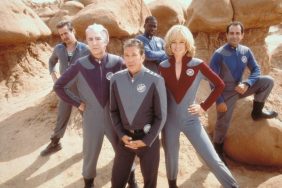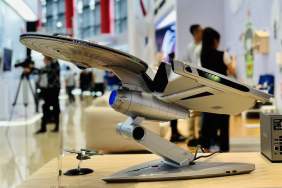Fred Topel is gallantly returning from the Delta Quadrant, having slipped out of the hands of his enemies, but is not yet back on Earth. As such, this will give guest author and resident Trekkie Witney Seibold one last Best Episode Ever installment on the “Star Trek” series.
Yes, the theme song sucks. Badly. I agree.
Quite easily the least popular of the “Star Trek” series (it’s even rated below the oft-forgotten Animated Series, which at the very least has some cult appeal), “Enterprise,” I feel, gets a bum rap. This was an attempt by the show’s creators to shake up “Star Trek” and give us something entirely new. After all, “Next Generation,” “Deep Space Nine” and “Voyager” all took place within the same timeframe and the same continuity. Many felt that “Star Trek” was getting a little stale, and, with 21 seasons between those three shows, time had come for a change.
The idea was to set the new “Star Trek” show (originally just called “Enterprise,” but eventually retitled to “Star Trek: Enterprise”) in a new time frame entirely, starting a brand new continuity that wouldn’t overlap with any of the previous shows. Set about a century before the events of the original “Star Trek,” “Enterprise” followed the exploits of the very first Earth crew to go on an extended space mission of discovery on the very first long-range Earth vessel (the USS Enterprise NX-01). What’s more, the aesthetic and tone of the show were also drastically altered. The ship wasn’t posh anymore, but looked more like a space shuttle. The pacing was slower, and the bigger vastness-of-space philosophical ideas kept at a mellower ebb. The characters were deliberately broad heroic archetypes, and the technology pointedly crude (comparatively speaking).

All of these sound like good ideas on paper, and, in my mind, the show was a success. Despite the higher quality of the show, a more sophisticated set of special effects, some entirely new species and historical conflicts in the “Star Trek” universe we had never heard of before, and the initial inclusion of a really attractive model on the crew (they learned their lesson from Seven of Nine), “Enterprise” always staggered through the ratings, and was met with indifference from the Trekkie community. “Enterprise” only lasted four seasons before being cancelled.
This is a pity. I may be one of the only defenders of “Enterprise” in the world, but I feel the show was brash and exciting. I really enjoyed going back to a time in the “Star Trek” universe when “unexplored” was the vast bulk of the space-faring experience. By “Voyager,” most of the galaxy had been mapped, leaving “the unknown” kind of an afterthought. “Enterprise” gave that uncertain feeling back. There was no Prime Directive yet, either, so this crew was bound to make some pretty drastic mistakes.
True, the third-season 9/11 metaphor was a bit forced (an un-encountered alien species called the Xindi unexpectedly destroys Florida, and the Enterprise becomes a war vessel), and time travel played a little too heavily into many episodes, but I kind of appreciate the archetypal approach to the material. It makes “Enterprise” feel pleasantly old-fashioned. Classical. Like a well-worn 1950s pulp novel. Like an astronaut adventure with real life astronauts! Gee whiz!

“Enterprise,” then, thanks to this “astronaut” approach, was a bit more mechanical and procedural than its forebears. One of the best elements of “Star Trek” which I haven’t mentioned in any of the other Best Episode Ever articles is its bare technical savvy. The Trek shows have always given a believable (if not necessarily realistic) depiction of what life would be like on these technologically advanced ships and stations. We see where the crew sleeps, their command structure, how the ship works, how it is operated, what the crew does for food and entertainment. “Star Trek” has always been a little bit grounded in the scientific, even if the technologies are a little far-fetched. This engineering element has made the shows a favorite of scientists and engineering students for generations.
It’s from this thinking that I pick the best episode of “Enterprise,” which is the second season episode “A Night in Sickbay,” which aired on October 16th, 2002.

This episode contains no major dramas, no political notions, and is actually free of the philosophizing that marks Trek. This is a straightforward day-in-the-life story where the only thing at risk is the life of a beagle. It’s a depiction of mere everyday life on the ship, and how living in space can be, well, without incident for long stretches. Boring. Living on a long-distance deep-space vessel can be boring for the crew. “A Night in Sickbay” is the kitchen sink realism episode of “Star Trek.”
The story is pretty simple: Capt. Jonathan Archer (Scott Bakula) takes his beagle Porthos to Dr. Phlox (John Billingsley, the best actor on the show) complaining of an illness. It seems the dog has contracted a rare alien illness on a recent failed diplomatic mission, and has to stay in sickbay. Unwilling to leave his dog, Archer stays by his side. The rest of the episode is a frustrated conversation. Archer gets to see what Phlox does in sickbay all the time (Phlox belongs to a species that hibernates). Occasionally, Porthos requires a treatment, and Archer freaks out.

The gregarious Phlox, possessed of many medical degrees, also takes the opportunity to psychoanalyze Archer, and unveil the stresses he refuses to reveal. This is the first time that “Star Trek,” a series that, by necessity, must take place mostly indoors, deals with the notion of cabin fever. Archer is restless and frustrated. He feels a little claustrophobic. And he’s sexually frustrated, especially working with his Vulcan first officer T’Pol (Jolene Blalock) who looks like a swimsuit model.
And that’s it! There’s no big dramatic payoff (the dog is eventually cured using a brain operation), Archer admits that his first officer is hot. He banters with a member of his crew that he doesn’t ordinarily talk to. And he frets about his dog. In a way, it’s a calming relief to see a Starfleet vessel during its downtime. The times when there’s nothing to do bulk sulk about the crappy job you may be doing, fret about what your crew thinks of you, and wander the halls of your tiny ship.

“Star Trek” has always been good about exposing the human condition, right? And while big philosophical truths are always explored, there’s also something downright human about dealing with boredom and restlessness. Humans aren’t necessarily bogged down with “big” moments. Sometimes we just have to do our jobs, sometimes mess it up, and fret about the little things. Being bored and petty is just as much a part of our makeup just as being heroic and insightful is.
So, sorry, no thrills, no aliens, no technologies. Just life aboard a ship during downtime. Finally seeing the downtime enriches the “Star Trek” universe exponentially. Plus, we learn that Starfleet captains aren’t necessarily going to be the staid, aloof, resolute decision-makers that they have been to date. Especially in the early days. Sometimes, well, they’re just human.
And isn’t that the point of all this?
Witney Seibold is a featured contributor on the CraveOnline Film Channel, and co-host of The B-Movies Podcast. You can read his weekly articles Trolling, Free Film School and The Series Project, and follow him on “Twitter” at @WitneySeibold, where he is slowly losing his mind.





